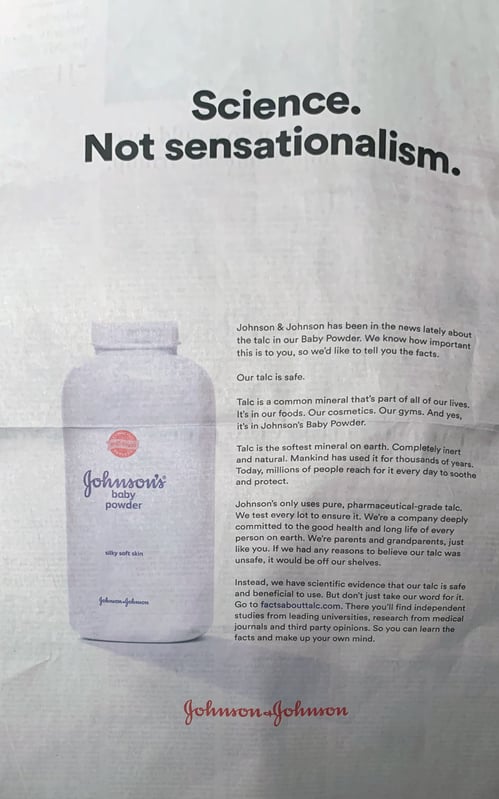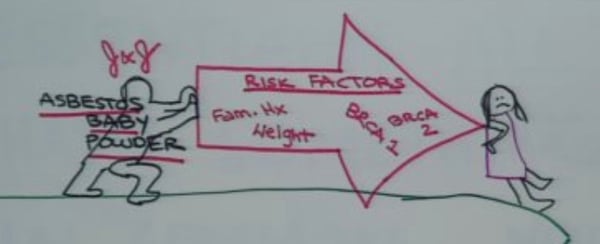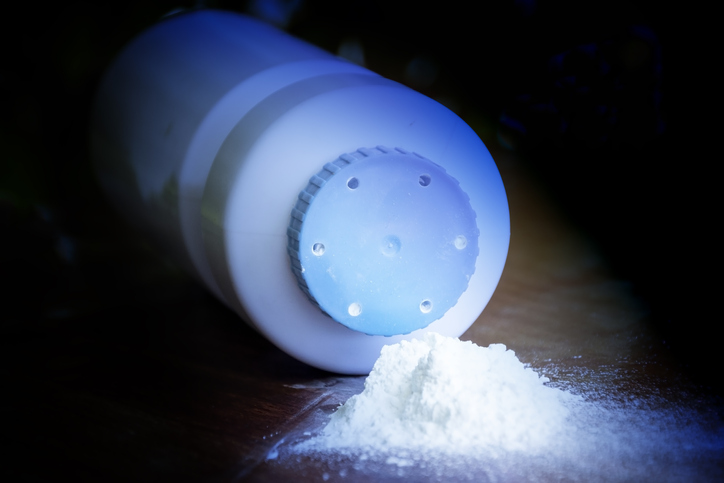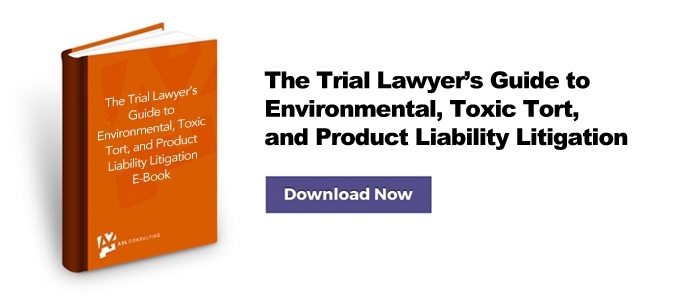A couple of years ago, I was involved in running a genetics conference focused on using genetics as a defense tactic in civil cases, much in the way that DNA evidence is used in criminal cases. I've been working with experts in this field ever since.
A few months back, I wrote an article about the clever use by plaintiffs of litigation graphics and genetics in the baby powder (talc) cases (see Some Lessons for Defendants From the Talc Liability Trials), including a $4 billion verdict against a major talc manufacturer. When I write about various types of cases, I often hear from lawyers who handle the types of cases I write about. On my post on the use of genetics evidence in the talc litigation, how many talc defense lawyers do you think I heard from? If you guessed zero, you'd be exactly right. And that's a problem.
Not ready to accept that this is a problem for defendants? Then I will ask whether the plaintiffs’ talc bar was similarly unresponsive. As you can probably guess from the way I posed the question, the answer is no. Out of discretion, I won't say exactly who or how many responded, but it was more than zero. Even though there is more to gain for the defense bar from understanding and leveraging these critical tools, it’s the plaintiffs’ lawyers who are most active in the field, striving to improve their approach. From the defense bar — crickets.
And that's the problem I'm seeing in the way some of these talc cases are being defended. Defense counsel appear to be playing defense – and completely ignoring the key point that the best defense in litigation is a good offense.
 These verdicts are having an impact on the companies involved. Last Friday, on December 14, 2018, shares of Johnson & Johnson fell 10 percent and were set to have their largest percentage drop in more than 16 years, after Reuters reported that the company knew for decades that there was some asbestos in its baby powder. Yesterday, December 18, 2018, Johnson and Johnson ran the full page ad seen here in an attempt to manage this growing crisis.
These verdicts are having an impact on the companies involved. Last Friday, on December 14, 2018, shares of Johnson & Johnson fell 10 percent and were set to have their largest percentage drop in more than 16 years, after Reuters reported that the company knew for decades that there was some asbestos in its baby powder. Yesterday, December 18, 2018, Johnson and Johnson ran the full page ad seen here in an attempt to manage this growing crisis.
For trial lawyers and litigation consulting firms like ours, these asbestos allegations are not new or surprising. It's what plaintiff's have alleged recently and have used to prevail in these cases. The surprising thing in these cases is defense counsel's unnecessarily passive approach.
When products are accused of causing harm, defense lawyers often choose one of the following defense strategies:
- Assert the harm was caused by something else but we don’t know what (the “idiopathic” defense)
- Assert the harm was caused by something else and we know exactly what.
Typically, most defendants have chosen the ‘we don’t know what other thing caused it’ strategy because it avoids giving up the favorable allocation of the burden of proof and assuming the very specific (and often difficult) burden of proving an alternative cause – much as criminal defendants take advantage of the “beyond a reasonable doubt” standard. Not surprisingly, this argument generally falls flat.
Recently, the plaintiffs’ bar won a multi-billion-dollar verdict by asserting that there is asbestos in talc and that it causes mesothelioma. This is highly improbable for several logical reasons — but jurors tend to follow emotion first and logic second when deliberating. If asbestos is present in baby powder at all, it would be in such small amounts that one could not reasonably connect mesothelioma to it.
If defense counsel asserts (as they have been) that the mesothelioma was caused by some other identified source of asbestos, and not by talc, that leaves jurors without the necessary tools to argue for a defense verdict during deliberations.
So, what if defense counsel could instead prove that the plaintiff’s mesothelioma was caused by something other than asbestos in baby powder? Something identifiable, measurable, and specific. Using modern genetics, this is now possible. And it is a major sea change.
Just as lung cancer is not always caused by smoking and heart disease is not always caused by eating fatty foods, sometimes it is a genetic flaw that causes cancer — in this case, mesothelioma.
Now, using a simple blood test, defense counsel can prove that a plaintiff’s mesothelioma was caused by their own genetics — not by an exaggerated exposure to a few asbestos fibers in baby powder. In a smoking case where a 55-year-old plaintiff smoked a handful of cigarettes in his youth and now alleges lung cancer, a similar strategy should be deployed.
It is worth mentioning that such a strategy is untenable in a high-exposure case (e.g., a shipyard worker or installer of asbestos-filled products). Of course, these are not the cases that the baby powder industry is defending and, in some instances, losing.
Instead, invoking the “thin-skulled plaintiff” metaphor, the plaintiffs’ bar is smartly suggesting that the plaintiffs’ compromised genetics make certain plaintiffs more vulnerable to talc. This is precisely where the fight is now. Yet, the defense bar isn’t always taking the fight head on by, among other things, seeking to exclude this evidence.
The best responses to this argument are scientific, rhetorical, and visual.
First, defense counsel must, where appropriate, put themselves in a position to take on this argument directly by conducting genetic testing. Right now, plaintiff's counsel are not doing genetic testing and asserting a genetics argument. That is not okay.
Second, having discovered through genetic testing a plaintiff’s genetic predispositions, defendants should present the test results and scientific testimony that establish that a plaintiff’s mesothelioma was the result of genetic abnormalities and not exposure to baby powder (which almost assuredly contains no asbestos or negligible levels of asbestos). The discovery of a plaintiff’s genetic abnormality should be affirmatively used to disprove exposure – in other words, plaintiff’s mesothelioma did not result from genetic frailties PLUS (highly suspect evidence of) exposure, but from those frailties alone. In short, plaintiff was destined by virtue of a form of genetic roulette to develop cancer without any help from a suspect or infinitesimally small exposure.
We know this not just from the testing, but also from family history. Cancer runs in families. In fact, we know that there is a one in three chance of being diagnosed with cancer if one’s sibling has developed cancer. Studies show that 30% of breast cancers are attributed to heredity. Having a parent, sibling or child with lung cancer doubles your risk of developing lung cancer. The statics are even worse for prostate cancer – a 72% risk in men with a family history. Mesothelioma is no different from these other cancers.
Third, plaintiffs’ counsel are winning with litigation graphics like this one below. I discussed this in the talc article that I mentioned above and linked here.

Instead, defense counsel should be owning this litigation graphic and showing in similarly simple terms that it is the plaintiff’s unfortunate genetics, and not some contrived or fleeting exposure otherwise hard to square with the manifestation of disease, that caused his or her cancer. A PowerPoint like the one below (converted to video for easy viewing) could use plaintiff's own demonstrative against them and neutralize these highly specious attacks.
I'm wondering who will email me this time. As of today, A2L does not have a conflict in these cases for either jury consulting work or litigation graphics work. It's lopez@A2LC.com.
Other articles from A2L Consulting related to litigation graphics consulting, mock trial work, and the intersection of science and litigation include:
- Some Lessons for Defendants From the Talc Liability Trials
- With So Few Trials, Where Do You Find Trial Experience Now?
- 7 Key Takeaways from the Genetics in Civil Law Conference
- Free slide decks from the Genetics in Civil Law Conference
- Free E-Book: The Litigator's Guide to Combating Junk Science - 2nd Edition
- Repelling the Reptile Trial Strategy as Defense Counsel - Part 3 - Understanding the Bad Science
- The Importance of Litigation Graphics in Toxic Tort Litigation
- 10 Key Expert Witness Areas to Consider in Your Next Toxic Tort Case
- Free Download: Using Science to Prevail at Trial or As an Advocate
- 7 Reasons the Consulting Expert is Crucial in Science-Based Litigation
- Using Trial Graphics & Statistics to Win
- 12 Questions to Ask When Hiring a Trial Graphics Consultant
- Repelling the Reptile Trial Strategy as Defense Counsel - Part 1
- Teaching Science to a Jury: A Trial Consulting Challenge
- 5 Valuable (and Free) Complex or Science-Focused Litigation Resources
- Winning BEFORE Trial - Part 3 - Storytelling for Lawyers
- 7 Times When Litigation Graphics Hurt You






Leave a Comment